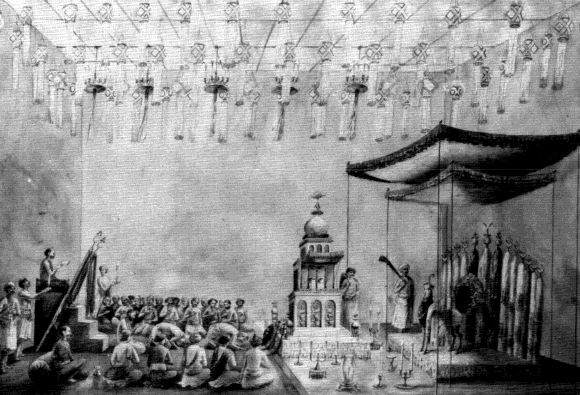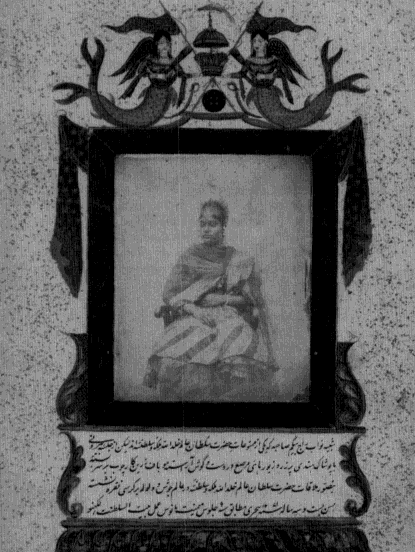The Mourning Session
Two central rituals for Shi‘is dominated Muharram: the mourning session (majlis ), held in an imambarah or a private dwelling, and the procession. The procession, by far the more ancient of these rituals, originated at least by the time of the Shi‘i Buyid dynasty in early-tenth-century Iraq. The stylized mourning session developed during the Safavid period in Iran, though gatherings to mourn the martyred Husayn had more ancient antecedents.[56] In Awadh in the early nineteenth century, notables held mourning sessions in their imambarahs twice a day during the first ten days of Muharram. The evening sessions, with their dazzling lighting derived from myriads of candles, mirrors, and chandeliers, were the best attended. The host and his male relatives sat on the carpeted floor near the cenotaph, the guests crowding in wherever they found room. The host hired a mawlavi to read that day's passage from a Persian prose text that described the sufferings of the Imam Husayn and his supporters and family in their struggle against the Umayyads. Among the Persian-educated notable class in Awadh, such readings could be extremely effective, particularly if the mawlavi wept and groaned with great sincerity from his minbar.[57]
[54] AliObservations , p 21
[55] Ibid., p. 28.
[56] For mourning sessions, see Mahmoud Ayoub, Redemptive Suffering in Islam A Study of Devotional Aspects of 'Ashura' in Twelver Shi ism (The Hague Mouton, 1978), pp 158ff., Jean Calmard, "Le Patronage des Ta'ziyeh Elements pour une étude globale," in Chelkowski, ed, Ta'ziyeh , pp 121-23, and Peter J. Chelkowski. "Ta'ziyeh. Indigenous Avant-Garde Theatre of Iran," in ibid., pp 3-4.
[57] All, Obserations , p 22

Figure 2
Rawzah-Khvani (mourning session). Courtesy of the British Library.
Since this role only required some Persian education, the mawlavi could be one of the subaltern ulama or even relatively untrained in specialized religious sciences. High ulama often held their own sessions, where they tied their recitations of the martyr's sufferings more closely to Arabic oral reports from the Imams, a style known a hadis-khvani . One of his students described Sayyid Muhammad Nasirabadi, then Lucknow's chief mujtahid, reciting oral reports from the Imams with translation: "I found him on the tenth of Muharram in the mourning session mentioning the calamities that befell the Martyr at Karbala, weeping violently, as was his audience. Then he descended from the minbar, barefoot, bareheaded, tears streaming from his ruddy cheeks. This was always his wont on such days. He thereafter went home and people gathered there."[58]
After the Persian reading, called the "ten sessions" (dah majlis ) because the works read from had ten chapters (one for each of the first ten days of Muharram), came an intermission during which servants handed around sweetened rose water to the gathering of mourners. Devout Shi‘is in the 1820s refrained from chewing betel leaves during Muharram, so servants passed about an assortment of spices on small silver trays. The highest-ranking members of the assembly smoked water pipes during the intermission, though the rest of the guests, of even slightly lower rank, dared not join them.[59]
After the refreshments, specialized reciters chanted elegiac poetry in Urdu. Even the illiterate could understand this part of the session, which must have formed the core of popular mourning sessions. Some of the verses had refrains, and the whole assembly often joined in.[60] In the early nineteenth century some reciters of such poetry employed a vocal technique that approximated singing. Readers presented verse works commemorating the martyrdom of the Imam Husayn in various rhetorical styles. The ulama favored the straightforward reading of the poetry (tahtal-lafz-khvani ), similar to that practiced by poets in secular poetry readings. Another style, antedating in India the rise of Shi‘i culture in Awadh, involved the chanting (suz-khvani ) of elegies. In Asafu'd-Dawlah's time Haydari Khan, a great singer, further innovated in this field, teaching Sayyid Mir ‘Ali, a highly respected performer at the court of Sacadat ‘Ali Khan. In such performances the musical modes (raginis ) could be emphasized or played down, according to taste. Women, and artisans and laborers, whether Shi‘i, Sunni, or Hindu, greatly loved the more musical styles. At the time of Ghaziyu'd-Din Haydar (1814-27) people came from all over Awadh to Lucknow during Muharram in hopes of hearing the courtesan Lady Haydar sing elegiac lyrics mourning
[58] Muhammad Mihdi Lakhnavi Kashmiri, Nujumas-sama " takmilah , 2 vols. (Qumm. Maktabat-i Basirati, 1397/1977), 1 245.
[59] Ali, Observations , p 23; cf. Sharar, Guzashtah Lakhna'u , p 358, Eng trans, p. 216
[60] Ali, Observations , p 23; Roberts, Scenes 2:192.
the Imam.[61] Women commonly sang marthiyyahs in public, though the ulama condemned such mixed meetings.
Some of the more strict, legal-minded Shi‘is questioned Sayyid Dildar ‘Ali Nasirabadi about the singing of elegiac poetry. He replied that listening to elegiac verses for the Imam Husayn, weeping for him, and mourning him all have great rewards. If read with a sorrowful and pained voice, they presented no difficulty at all. But he disapproved of chanting marthiyyaghs with remodulation (Persian tarjic , Urdu katkar ) as being too close to music, promising that anyone who avoided listening to such performances would be spiritually rewarded.[62]
After the mourning verses the entire congregation rose and enumerated the legitimate successors after the Prophet Muhammad according to Shi‘is, the Twelve Imams, asking blessings upon them individually. Then they repeated the names of the early caliphs, whom Shi‘is regard as usurpers, pronouncing imprecations on them. These two rituals consisted of taking an oath of allegiance (tavalla ) to the Imams and pronouncing imprecations (tabarra ') on the caliphal usurpers.[63] The mourning session concluded with a frenzied period of self-flagellation called the obsequy (ma'tam ). Even Shi‘i notables practiced it, Mrs. All reporting of upper-class ceremonies: "I have even witnessed blood issuing from the breast of sturdy men, who beat themselves simultaneously as they ejaculated the names 'Hasan'! 'Hosein'! for ten minutes, and occasionally during a longer period, in that part of the service called Mortem."[64]
Again, the ulama disapproved of flagellation. Mrs. All wrote that "Maul-vees, Moollahs, and devoutly religious persons" never joined in beating their breasts, although they were present in the audience while others thus violently expressed their grief. The ulama carried on their own mourning practices for longer than most believers in the 1820s, for a full forty days. They apparently did not participate in the mourning processions.[65] Sayyid Muhammad Nasirabadi, asked about self-flagellation in the 1820s or 1830s, replied that wailing and healing one's chest over the calamities that befell the family of the Prophet was only permissible if one lost control of one's self.[66]
Women also commemorated Muharram, though only a few princesses and wealthy courtesans had their own imambarahs . Almost all the hostesses made their best room in the ladies' quarters into a temporary imambarah , allowing only females in. Mrs. All thought the grief of women during the first ten days of Muharram greater than that of men, such that pious women
[61] Sharar, GuzashtahLakhna'u , pp 211-17, trans, pp 139, 147-50 and notes.
[62] Nasirabadi, "Najat as-sa'ilin," fol. 22a
[63] Ali, Observations , p 23, Sharar, GuzashtahLakhna'u , p. 105, Eng trans, p 86.
[64] All, Observations , pp 22-23.
[65] Ibid., p. 30.
[66] Musharraf ‘Ali Lakhnavi, ed, Bayaz-imasa'il , 3 vols. (Lucknow n.p., 1251/1835-36), 3:37.

Figure 3
An upper-class Shi‘i woman of Awadh: Nawab Raj Begam Sahibah.
Born c. 1832, wife of Vajid ‘Ali Shah. Courtesy of the British Library.
would neglect their private sorrow during that period. In Hyderabad, Shi‘i women beat their breasts in self-flagellation, just as did men.[67] In Lucknow, women gave up betel leaves, the wearing of jewelry, and bright (especially red) clothes, instead loosening their hair and garbing themselves in dark colors. Some even mortified themselves by wearing their mourning clothes in torrid, sultry Lucknow for ten solid days. Mrs. Ali's serving-maid went the entire time without drinking water during the day. Every evening the ladies gathered about the cenotaph they had set up. with female friends, slaves, and servants surrounding the hostess.[68]
As elsewhere in the Shi‘i world, educated women presided at these distaff sessions.[69] In Awadh they derived for the most part from indigent Sayyid families that lacked the dowry to attract a high-status Sayyid groom but refused to accept one from a less prestigious caste, in accordance with the hypergamy (marrying up bu?? not down) widespread among Indian Muslims. They often served as Qur'an teachers for the daughters of notable families. Hostesses hired them for the first ten days of Muharram, presenting them in remuneration not only with a fee but with fine gifts as well. They read both the Ten Sessions in Persian and the elegiac poetry in Urdu.[70]
The mourning sessions held in homes during Muharram and during other months of the Shi‘i sacred calendar provided crucial opportunities for the development of social networks among Shi‘is, whether male or female, notable or commoner. Mourners went from session to session, spreading news and giving Shi‘is of one neighborhood or village a sense of unity with their coreligionists elsewhere. Lucknow became a place where Shi‘is from all over Awadh could meet at Muharram and thus overcome their sense of being isolated minority communities through congregation in the Realm of the Shi‘ah. The sessions reflected in their social composition the class and status of the host, with tradespeople excluded from notable gatherings. But within social classes and neighborhoods, the sessions did much to foster a sense of community identity.